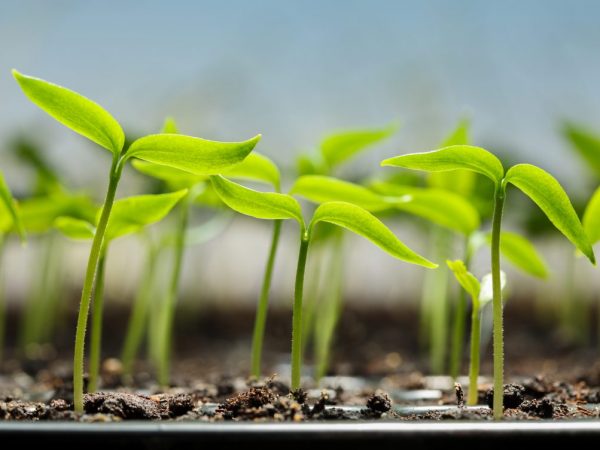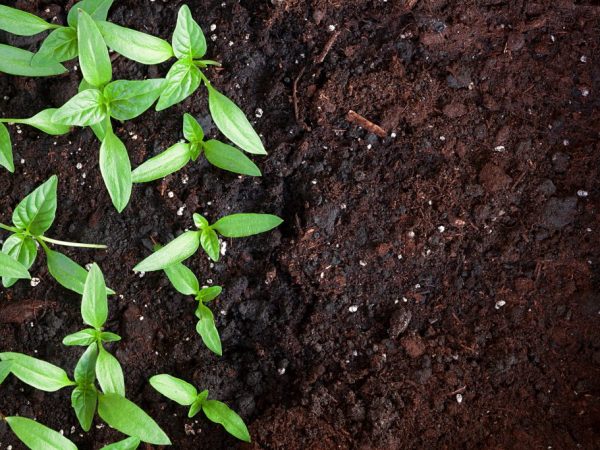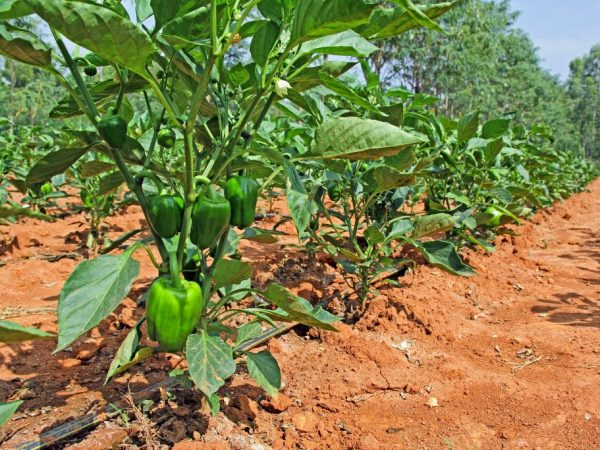When to plant peppers in 2018
Planting peppers correctly in 2018 will ensure high and long-lasting yields. In addition to general recommendations, there are landing dates for the lunar calendar. Consider how to plant peppers correctly, the best planting time and care recommendations.

Planting pepper
When to plant peppers
To correctly calculate the timing of planting pepper in 2018, the following factors must be taken into account:
- growing season;
- seedling age;
- seedling planting time;
- seed germination period;
- harvest period;
- climate.
Vegetation period
This is the period from germination to the moment of fruit ripeness. It ranges from 85 to 130 days, depending on the variety. This information can be found on the seed packet.
Seedling planting time
It is customary to transplant seedlings into the ground when the first flower appears in the first fork. This occurs between 50 and 85 days of age, depending on the variety of pepper. At this point, the transplant is best tolerated by the plants. They take root faster and are less susceptible to disease.
If you plan to grow pepper in the open field, the timing depends on the weather conditions. If a greenhouse is supposed to be used, it should be taken into account whether it has the possibility of additional heating in the event of a decrease in the air temperature.
Seed germination period
Usually, seeds germinate from 10 to 15 days, but in some cases, the period is extended to 25 days. There are ways to speed up this process, so if the gardener is delayed planting the pepper in 2018, you can use seed pretreatment and catch up with 10 to 18 days.
Harvesting period
Depends mostly on the variety. Dates start in June and end in autumn. If you use different varieties when planting, you can increase the fruiting period by several months.
Climate
This is one of the most important factors in determining when to plant sweet peppers in 2018. First of all, seedlings can be planted in the south (Rostov, Krasnodar, Crimea) - from March 1 to 15 in a greenhouse and from April 15 to 20 in open ground. If we are talking about the Moscow region, then the dates for disembarkation in the greenhouse are from May 1 to 10, and in the open ground - from June 5 to 15. Based on these data, you can calculate the approximate timing of sowing seeds.
Lunar landing dates

Peppers must be planted correctly
Seed germination depends on in what phase of the lunar cycle they were sown. There are lunar calendars that take this and other parameters into account.
Some people are skeptical about the use of the lunar calendar, but some of the phenomena are scientifically based. For example, with the growing moon, water molecules are on the upper part of the plant, therefore, during the new moon, plants are planted, the fruits of which grow above the ground, and then roots are planted.
Thus, you can start planting peppers in January or February 2018. Each month, the gardener has about 2 weeks to plant each crop.According to the lunar calendar, you cannot plant anything on the full moon, as well as during the next 2 days. Specific dates are determined by the position of the moon in the signs of the zodiac.
Better days
The best landing days:
- Auspicious days for planting peppers in January 2018: 10, 11, 12, 29 and 30.
- Auspicious days in February: 14, 16 and 23.
- In March: 3, 4, 12, 14, 20, 30, 31.
- In April: 9, 11, 18, from 26 to 28.
- In May, it is best to transplant seedlings into open ground on the 8th, 14th, 15th, 24th and 25th.
- In June, the transplant should be done on the 2nd, 11th and 20th.
The influence of the location of the moon has not been scientifically confirmed. This parameter is taken into account in the lunar calendar based on many years of experience in growing various crops.
Landing rules
In order to harvest peppers in 2018, it is initially necessary to properly sow their seeds. Attention should be paid to the following points:
- The procedure should be carried out in February or March, depending on the climate and whether it is an early variety or a late variety.
- It is recommended to purchase seeds from reputable producers It is advisable to use seeds that are no more than 2 years old.
- The seeds are dipped in a potassium permanganate solution for 20 minutes.
- For better germination, seeds are soaked in a growth stimulator. Use warm water with a temperature of up to 30 ° C. The seeds are left in solution for a day, then small ones are chosen, as well as those with defects and those that surfaced. They cannot give a full harvest.
- To test germination, the seeds are dipped in water. Quality sinks to the bottom.
- A good soil option is a 1: 1: 2 mixture of earth, sand and humus. It is also advised to add a little ash. You can buy ready-made soil for seedlings. Alternatively, use coconut substrate or special peat tablets. Moisten the soil before sowing.
- Peppers are planted both in separate containers and in a common tray. If you use the first option, put at least one seed in each pot, and preferably 2 or 3, and then leave the strongest seedling. The distance between the seeds in the trays is 2 to 3 cm.
- After sowing, the containers are covered with polyethylene, placed in a warm room and wait for the emergence of seedlings. The air temperature should reach 22 ° C.
If you follow these rules, you can get quality seedlings.
Seedling care

Good seedlings - good results
Seedlings provide favorable conditions for development. Pay attention to the following points:
- lighting;
- temperature;
- watering;
- top dressing;
- hardening.
Lighting
Containers with seedlings are installed so that a large amount of light falls on them. To prevent the plants from tilting to one side, they are deployed from the window every 3 days. Since the daylight hours are short in March 2018, it is recommended to arrange additional lighting. For this, fluorescent lamps or a special phytolamp are used. Seedlings should be exposed to light for 12 to 14 hours a day. If there is not enough light, the plants become thin and elongated. In April, the backlight is removed.
A mirror is used as an additional light source. It is placed facing the window. Alternatively, take plywood or cardboard and cover them with foil. You need to act carefully, make sure that the lighting does not become too bright. You can resort to this method when direct sunlight no longer falls on the plants. If containers with seedlings are in the back of the room, you need to put the mirror at an angle so that diffused light falls on the seedlings.
Temperature
It is necessary to monitor the temperature of the soil. It should not fall below 15 ° C. At temperatures below 13 ° C, the seedlings will stop growing. It is desirable that the temperature regime be as follows: on sunny days - from 23 ° С to 25 ° С, on cloudy days - from 20 ° С to 22 ° С, and at night - from 16 ° С to 18 ° С.
During the day, plants breathe, the process of photosynthesis takes place. At the same time, they lose some useful substances. At night, when there is no light, photosynthesis stops or slows down. Saplings store energy for further development.If they are not removed to a lower temperature room, they will continue to waste energy. Nutrients will be consumed instead of being stored. As a result, the seedlings will become weaker.
Watering
Water the seedlings abundantly. If there is a lack of moisture, there is a risk that the fruit will be small and tasteless. The procedure is carried out every 2-3 days. When real leaves appear, they begin to water daily. After the seedlings get stronger, they are watered less often, but more abundantly. This is recommended in the morning. Care must be taken not to let water droplets fall on the leaves.
Excess moisture in the soil leads to root rot. The water should be at room temperature. If it is too cold, the seedlings will get sick and die. It is also necessary to maintain sufficient air humidity. To do this, spray the seedlings directly or use a humidifier.
Top dressing
Until the moment of disembarkation on the site, the seedlings are fed once or twice. The first feeding is carried out 14 days after the appearance of the first 2-3 leaves. The necessary fertilizers are bought at the store or natural remedies (humus, urea, compost and manure) are used. If there is a need, a second feeding is carried out three days before planting seedlings in open ground.
Hardening
Hardening of seedlings is carried out 2 weeks before planting in open ground. The plant is taken out into the fresh air, avoiding the north winds. Seedlings are exposed to lighted areas. This helps prevent them from burning up after being planted in open ground.
The outside air temperature should reach 15 ° С. The exposure time is gradually increased, starting at 20 minutes per day. During the hardening period, watering is reduced, as well as the air temperature in the room.
Conclusion
Since ancient times, people have gained more and more experience in caring for this culture. There are both general recommendations on the timing of planting pepper, and recommendations for the lunar calendar. Seeds planted on time will bring a high yield of a sweet and tasty vegetable.


